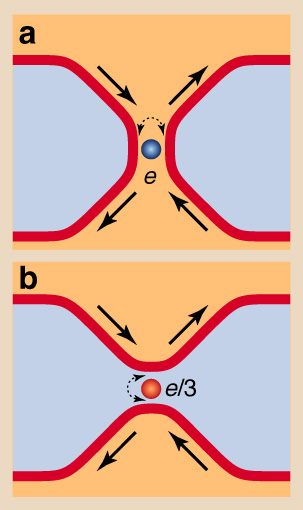


A quantum point contact in a two dimensional electron gas (blue). Based on the theoretical work of C.L. Kane and M.P.A. Fisher, such a device has recently been used to measure the fractional charge, e/3, of the Laughlin quasiparticle in the fractional quantum Hall effect. Quasiparticles flow along the one-dimensional edges as indicated by the arrows. (a) In the strong pinch off limit, electrons tunnel from left to right, while (b) with weak pinch-off, fractionally charged quasiparticles tunnel between the top and bottom edges through the electron gas.
![]() In a quantum wire, electrons are confined
to a narrow one dimensional channel with motion perpendicular to the channel
quantum mechanically frozen out.
Such wires can be fabricated using modern semiconductor technologies
such as electron beam lithography and cleaved edge overgrowth.
In addition, Carbon nanotubes are ``self assembled" quantum
wires, with fascinating electronic properties.
Electronic phenomina are
much more subtle in one dimension than in three.
Whereas in higher dimensions
Landau's ``Fermi liquid" theory usually applies, it has been known
since the 1960s one dimensional is special. There even weak
electron-electron interactions destroy the Fermi surface.
While the usual approximations for dealing with electron interactions
break down, there exists a remarkably simple description
of the one dimensional problem known as ``Luttinger liquid" theory.
The Luttinger liquid is of fundamental importance because
it is one of very few strongly correlated ``non Fermi liquid" systems
that can be analyzed in any detail.
In a quantum wire, electrons are confined
to a narrow one dimensional channel with motion perpendicular to the channel
quantum mechanically frozen out.
Such wires can be fabricated using modern semiconductor technologies
such as electron beam lithography and cleaved edge overgrowth.
In addition, Carbon nanotubes are ``self assembled" quantum
wires, with fascinating electronic properties.
Electronic phenomina are
much more subtle in one dimension than in three.
Whereas in higher dimensions
Landau's ``Fermi liquid" theory usually applies, it has been known
since the 1960s one dimensional is special. There even weak
electron-electron interactions destroy the Fermi surface.
While the usual approximations for dealing with electron interactions
break down, there exists a remarkably simple description
of the one dimensional problem known as ``Luttinger liquid" theory.
The Luttinger liquid is of fundamental importance because
it is one of very few strongly correlated ``non Fermi liquid" systems
that can be analyzed in any detail.
Our work in this field has largely been a collaboration between C.L. Kane and Matthew Fisher from the ITP in Santa Barbara. Our contribution has been to establish the relevance of Luttinger liquid theory to quantum wires, and to extend it in a number of directions which allow for detailed comparison between experiment and theory. In particular, we developed a theory to describe the effects of a single impurity in an otherwise perfect wire. We showed that even a weak impurity has a dramatic effect at low temperatures. Our theory makes specific verifiable predictions regarding the tunneling and resonant tunneling through the impurity. This work has stimulated a large body of experimental and theoretical work. On the theoretical side there are deep connections between this work and recent developments in conformal field theory. Experimentally, recent measurements of quantum wires by Tarucha et al. from NTT research in Japan have found that the temperature dependence of the conductance is consistent with our theory. However, the most impressive experimental confirmation of the Luttinger liquid theory has occurred in the study of edge transport in the fractional quantum Hall effect, which is described below.
The analog of the single impurity in a quantum wire is a quantum point contact in the quantum Hall effect, shown in the figure above. Early experiments by Milliken, Umbach and Webb at IBM observed the power law temperature dependence of the conductance which we predicted. Moreover, a detailed analysis of the lineshapes of resonances agreed quite successfully with the scaling theory which we developed. More recent experiments by Chang, Pfeiffer and West at Lucent Technologies used a slightly different geometry and observed the power law behavior over six orders of magnitude in voltage. Our theory also suggested that measurement of the temporal fluctuations of the current in a point contact would allow for a direct measurement of the fractional charge of the Laughlin quasiparticle. This prediction has recently been verified in two remarkable experiments carried out by de-Picciotto et al. from the Weizmann Institute and Saminadayar et al. from Saclay. The combination of these experiments and our theoretical work has led to the first observation of the Luttinger liquid, a state of matter whose existence was first predicted some 30 years ago.